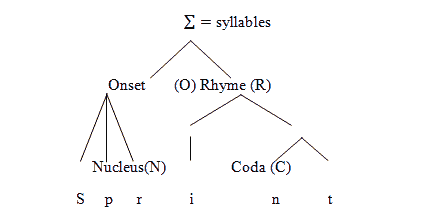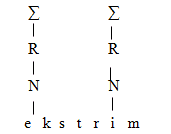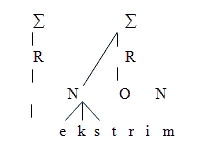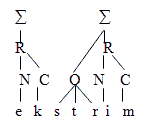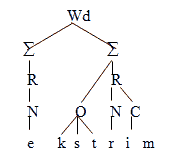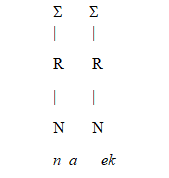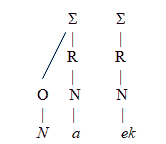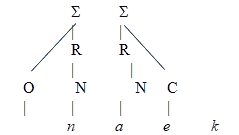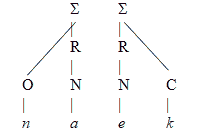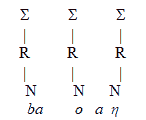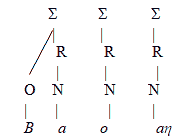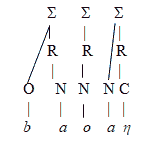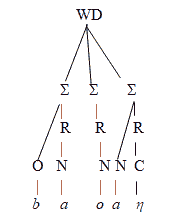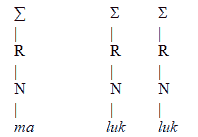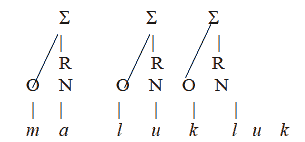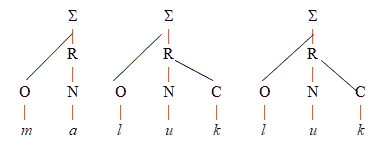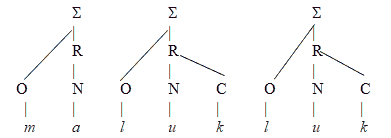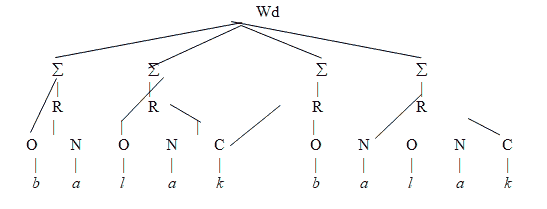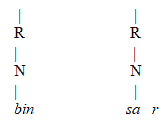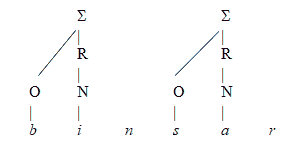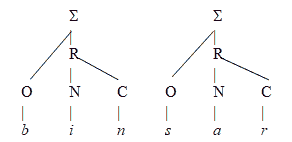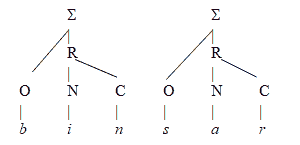Research Article: 2021 Vol: 27 Issue: 2S
Phonotactics in Toba Batak Language: Phonological Management
Jamorlan Siahaan, Universitas Sumatera Utara
Robert Sibarani, Universitas Sumatera Utara
Asni Barus, Universitas Sumatera Utara
Keywords
Vowel Sequences, Consonant Sequences, Management.
Abstract
This paper studied about the management of vowel sequences and consonant sequences in Toba Batak language. The management of vowel sequences and consonant sequences studied the sounds of language by imitating the speech of someone who uses his language and studied the sounds of language guided by sound symbols, and how speech organs can produce sounds perfectly, and analyze the sounds produced by human speech. The goal is to establish the management of phonotactic structure in the Toba Batak language. This study contributes as material or textbooks for high school (SMA) and as guidelines for the community. It also reveals the principles of language universality by segmenting language sounds, classifying patterns and classes of human language sounds, analyzing their phonological processes, explaining variations in word sounds, and describing changes in human language sounds. It also scientifically contribute is phonology as the study of sounds of language as the smallest unit of the combination of sounds that form syllables. The method used in this research is a qualitative method with interactive model that can reflect reality based on facts. Vowel sequences in this research consist of 44 pieces, that are: /ai-/, /-ai-/,/-ai/, /-ao-/, /-ao/, /au-/, /-au-/, /-au/, /ae-/, /-ae-/,/-ae/, /ia-/, /- ia-/, /-ia/,/iu-/, /-iu-/, /-iu/, /io-/, /-io-/, /-io/, /ua-/, /-ua-/, /-ua/, /-ui-/, /-ue-/, /-ue/,/ea-/, /-ea-/, /- ea/,/-eu-/, /-eu/, /-eo-/, /-eo/, /-oa-/, /-oa/, /-oi-/, /-oi/,/-io-/, /-ou/, /-uo/, /-aoa-/, /-uae-/, /-aio-/, and /-aua-/. Consonant sequences in this research consist of 32 pieces, that are: a) consonant sequences started with /k/ sound, are: /-kl-/, /-kb-/,/-kp-/, and /-kt-/. b) consonant sequences started with /l/ sound, are: /-lt-/. /-ls-/, /-lp-/, /-lg-/, and/-lb-/. c) consonant sequences started with /m/ sound, are: /-mb-/, /-mp-/, and /-ml-/. d) consonant sequences started with /n/ sound, are: /- nd-/, /-nj-/, /-nt-/, /-ns-/, /-ng-/, /-ngj-/, /-ngp-, /-ngt-/. e) consonant sequences started with /p/ sound, are: /-pr-/, /-ph-/, /-ps-/, and/-pg-/. f) consonant sequences started with /r/ sound, are: /- rg-/, /-rs-/, /-rj-/, /-rt-/, /-rh-/, and /-rn-/. g) consonant sequences started with /s/ sound, are: /-sr-/, /-sd-/, and /-st-/. h) consonant sequences started with /t/ sound, are: /-tm-/ and /-ts-/.
Introduction
Language investigators who want to get the best results need to know sound science and the use of it. Without know the sound science, he will not get the perfect result, because language is the first sound (Samsuri, 1987: 91). People can get the sound of language using the power of air movement and the touches of organs of the human body that can be started from the lungs to other organs such as: tongue, palate, gums, teeth, and lips. Phonologists will give great attention to describe and understand phonological vareation, especially linguists who have a background and interest in the social aspects of language.
These language variations that attract attention are divided into two, such as:
1. Sincronic variation, is language changes that occur in a certain period of time, dialects, sociolects, idiolects and others.
2. Diachronic variation, which involves changes in language from time to time (Suhendra, (1998: 11).
Language study is not only in the study of writings that can be read or pronounced. Therefore, studying sound science, the first we must understand the language system based on skills (Paitoon & Chaiyanara, 2001). There are two kinds of facilities for language, such as physical facilities of speech organs (tongue, mouth, lips, teeth, nose, etc.) and non-physical facilities, such as spirit, reason, mind, and taste which function to process all inputs from the natural surroundings.
There is a process of conceptualizing all these inputs, which are then born in the form of speech or writing, both in quality and quantity. Speech and writing are a reflection of the reasoning of the speaker, while the weight of written speech is the realization of the weight of reasoning. The most universal experience possessed by all humans is language. Language sounds are not suitable speak by a language user; the effect in the sound does not match with the actual sound. The using of language is better and more right, language users need to learn the language in more detail. The wrong of language is not only occurring in pronunciation, but also in writing system. As well we know, most writing systems cannot describe the sounds by humans perfectly when speaking, however perfect and modern the writing media can speak to themselves. The writing system functions as speech preservation, not regulating speech. It means the most important language is sound.
There is a process of conceptualizing all these inputs, which are then born in the form of speech or writing, both in quality and quantity. Speech and writing are a reflection of the reasoning of the speaker, while the weight of written speech is the realization of the weight of reasoning. The most universal experience possessed by all humans is language. Language sounds are not suitable speak by a language user; the effect in the sound does not match with the actual sound. The using of language is better and more right, language users need to learn the language in more detail. The wrong of language is not only occurring in pronunciation, but also in writing system. As well we know, most writing systems cannot describe the sounds by humans perfectly when speaking, however perfect and modern the writing media can speak to themselves. The writing system functions as speech preservation, not regulating speech. It means the most important language is sound.
The learning of regional languages, especially the Toba Batak language, until now cannot realized properly, due to the lack of understanding of the utterances conveyed by humans (Haholongan-Marbun, et al., 2018). Naturally skills of listening and speaking are very important things for people who really want to learn local languages. The teaching of regional languages has indeed been carried out in Indonesia, especially in the regions just like that and not aimed at developing Toba Batak language proficiency. It is a fact that not all sound rules in the Toba Batak language can be writing with sound symbols. So far the sound systems have not much attention in extracting knowledge or teaching the Toba Batak language. As the result, someone who use and learn the Toba Batak language in a long time is not also quite right to say the words in the pronunciation. The local knowledge is related to the people’s indigenous scholarship that the people use to overcome their social problems (Sibarani & Robert, (2018a); Sibarani, Robert, et al., (2018b); Sibarani & Robert, (2020)).
The result is, there are still many wrong in writes, when the language is dictated by both the Toba Batak language lessons and other regional languages (Sibarani & Robert, 2020). There are two ways to learn the sounds of language: the first is traditional / natural, which is to learn the sounds of language by imitating the words of someone who use the language. In this case, someone who imitates through association or through a process, teaching and learning between a student and a teacher. By this process, someone who will learn the language will not be able to master the sounds of the language properly and correctly. Because this method gets little attention to where and how the sounds of language are produced, this can result in unwanted wrong.
Therefore, language instructors are expected to have good ability regarding speech sounds. The second is by of scientific theory, which is studying language sounds guided by sound symbols, and how speech organs can produce sounds perfectly, and analyze the sounds produced by these speech organs. This method can make language learner and instructors can produce language sounds correct with the actual sounds, and can describe these sounds on written media. Deciphering language sounds into special parts, it calls segments which are the goal of phonology. In reality, we know acoustic phonetic investigations speech languages do not consist of separate segments, but connect together and are marked by overlapping adjacent sounds. (Adul-Chaer, (2013); 10-11,103).
Therefore, each native speaker of a language is often and without realizing that the sounds of language and variations of pronunciation in their own language can easily distinguish several segments which simultaneously sound the same, but different meanings (Izwar, et al., (2020)).
Literature Review
Phonotactics is a procedure of finding and determining the procedure sequence and connecting phonemes in a language based on distribution (beginning, middle, and end of the word) so that what is discussed in phonotactics is the pattern of sound sequences. Fromkin & Rodman (1993: 231) said that the constraints of a series of segments are called the phonotactic boundaries of that language. If we check English phonotactics, we find that the phonotactics of a word is basically based on syllable phonotactics. That is, only a consonant group that begin with a syllable starting with a word, and only a consonant group that can end a syllable can end a word. Hyman (1975: 10) said that there are also segmental boundaries which characterize phonetic levels which refer to phonetic segmental boundaries, where such boundaries are called segmental boundaries and in addition to segmental boundaries, there are also phonotactic boundaries. (Sequential constraints) and which can allude to a phonetic level or a phonological level, or both.
If we discuss the problem of phonological phonotactic boundaries and phonetic constraints, it means that in both levels, there are limits on how segments (sounds) can be combined sequentially. This can be mean that words or syllables can only start with certain segments or certain segments cannot occur before or after other segments (sounds). O'Grady & Friends (1989: 76-77) said that Phonotactics is a set of constraints on how the pattern of rows of sounds is form, forming part of the phonological abilities and knowledge possessed by speakers of that language. Syllables consist of two phonetic parts, such as:
1. The consonant before the vowel is called Onset (O),
2. Rhyme (R). Rhyme consist of two parts, such as:
a. Inti (Nucleus) or 'Peak' Hyman (1975: 188),
b. Consonants that follow the vowel are called coda (Figure 1).
Describing the books in two or more syllables in the Toba Batak language is guided by the four steps of the opinion of O'Grady, and others (1989: 79-80) said:
The first step, because the syllable nucleus is a mandatory constituent of a syllable, then the syllable nucleus is first determined in each tribe which is usually vocal, and on top of each Nucleus symbol (N) is placed Rhyme (R) , and above each Rhyme (R) is placed the Sigma symbol ( ? ) for the syllable delimiter (Figure 2).
The second step, the longest consonant row to the left of each Nucleus (N) that does not violate the phonotactic boundaries of a language is called the Onset (O) of the syllable (Figure 3).
The third step, this means that each remaining consonant to the right of each (N) forms a Coda (C). This coda is combined with the syllable nucleus to the left of the Rhyme (R). Syllables that end with Coda (C) in this case are called closed syllables (Figure 4).
The fourth step, connect the two syllables to form the word (Wd) (Figure 5),
From the opinion that the barriers of integrating some language sounds in one language are not necessarily obstacles for other languages, and in this case researchers are more like to follow O'Grady, and friends.
Vowel Sequences
Vowel sequences are two or more parallel vowels found in different syllables when pronounced as given from the definition of vowel series quoted from some linguist opinions below:
Aminoedin & Friends (1984: 140) said "vowel series are two or more vowels in line, but each is the peak of loudness of speech. it means different tribe. Alwi & Friends, (1998: 52) said "vowel series is the same or almost the same breath, both vowels are included in different syllables. "Example: series / -ao- /, and / -ae- / in the word / taon / 'year' and / maen / 'cousin'is a vowel series because each consists of two syllables: [ta-on] and [ma-En]. From the theory, it can be concluded that the vowel sequence is the same or almost the same where both vowels are included in different syllables. Researchers also agree with (Alwi et al., 1998: 52) and (Aminoedin & friends, 1984: 40) said that vowel series are two or more vowels in line but each is the peak of loudness of speech.
Consonant sequence
Consonant sequence is a combination of two consonants found in different syllables even though they are side by side as suggested by the writer's opinion. Pulgram (1970: 79) said that the combination of two or more consonants that occur in different syllables even though side by side is called a sequence. This opinion was also said by Alwi & friends (1998: 79): "A sequence is a combination of two or more consonants that occur in different syllables although side by side" (Figure 6).
Method
This research method applied was qualitative research with interactive model. Qualitative method is a procedure that produces descriptive data in the form of written or verbal data in the community. Qualitative approach that involves verbal data in a language and involves what is called the native language information of the language that researched. The descriptive method suggests that the research is only based on facts or empirically living phenomena from its speakers, so what is produced or recorded is in the form of language which is usually said to be like a portrait: exposure as it is. Interactive model applied was data collection, data condensation, data display, and conclusion drawing/verification (Creswell, 2017; Sibarani, Robert et al., 2020).
This descriptive role does not consider the correct of the use of language by its speakers, first and foremost characteristic (Sudaryanto, 1992: 62). Verbal data can we get from native speakers of the Toba Batak language in which respondents of the research based on location, social status, age and experience of the speaker.
Result and Discussion
The Management of Vowel sequences
Vowel sequence / -ae- /
There are 4 steps that must be following in determining the structure of the word telling in the Toba Batak language. Example: naek ‘up’
The first step, because the main syllable of the Toba language is a mandatory constituent of a syllable, then the syllable nucleus is first determined for each tribe that is usually vowel, and on top of each nucleus symbol (N) is placed Rhyme ( R), and above each Rhyme (R) is placed the sigma symbol (?) for the syllable delimiter (Figure 7).
The second step, Onset before code: The longest consonant sequence to the left of each nucleus (N) that does not violate the phonotactic boundaries of a language is call the onset (O) of the syllable (Figure 8).
The third step, every consonant on the right side of each nucleus (N) forms a coda (C). Syllables ending in coda (C) in this case call closed syllables (Figure 9).
The fourth step, connect the two syllables to form words (Wd) (Figure 10).
According to the steps above, book keeping from naek consists of two syllables, such as na-ek.
Vowel sequence /-aoa-/
There are 4 steps must be follow in the structure of the wordtelling in the Toba Batak language. Example: baoang ‘onion’.
The first step, because the main syllable of the Toba language is a must constituent of a syllable, then the syllable nucleus is first determined for each tribe that is usually vocal, and on top of each Nucleus symbol (N) is placed Rhyme ( R), and above each Rhyme (R) is placed the sigma symbol (?) for the syllable delimiter (Figure 11).
The second step, onset before coda: The longest consonant sequence to the left of each Nucleus (N) does not violate the phonotactic boundaries of a language is call the Onset (O) of the syllable (Figure 12).
The third step, every consonant on the right side of each Nucleus (N) forms a Coda (C).This coda is combined with the syllable nucleus to the left of the rhyme (R). The end syllables with Coda (C) in this case are call closed syllables (Figure 13).
The fourth step, connect the two syllables to form words (Wd) (Figure 14).
According to the steps above, bookkeeping from baoang ‘onion’ consist of three syllables, such as: ba-o-ang
The Management of Consonant Sequence
Consonant sequence /-kl-/
There are 4 steps must be follow in structure of the word telling in the Toba Batak language. Example: malukluk ‘curly’
The first step, because the main syllable of the Toba language is a must constituent of a syllable, then the syllable nucleus is first determined for each tribe that is usually vocal, and on top of each nucleus symbol (N) is placed Rhyme ( R), and above each Rhyme (R) is placed the sigma symbol (?) for the syllable delimiter (Figure 15).
The second step, onset before coda: The longest consonant sequence to the left of each nucleus (N) does not violate the phonotactic boundaries of a language is call the onset (O) of the syllable (Figure 16).
The third step, every consonant on the left of each Necleus (N) form Coda (C). This coda is combined with the syllable to the left of the Rhyme (R). The syllable ending with Coda (C) in this case is call a closed syllable (Figure 17).
The fourth step, connect the two syllables to form words (Wd) (Figure 18).
According to the steps above, bookkeeping from the maklukluk ‘curly’ consist of 3 syllables, such as: ma-luk-luk.
Consonant Sequence /-kh-/
There are 4 steps must be follow in the structure of the word telling in the Toba Batak language. Example: balakbalak ‘kotoran’
The first step, because the main syllable of the Toba language is a must constituent of a syllable, then the syllable nucleus is first determined for each tribe that is usually vocal, and on top of each Nucleus symbol (N) is placed Rhyme ( R), and above each Rhyme (R) is placed the sigma symbol (?) for the syllable delimiter (Figure 19).
The second step, onset before coda: The longest consonant sequence to the left of each Nucleus (N) does not violate the phonotactic boundaries of a language is call the Onset (O) of the syllable (Figure 20).
The third step, every consonant on the left of each necleus (N) form coda (C). This coda is combined with the syllable to the left of the rhyme (R). The syllable ending with coda (C) in this case is call a closed syllable (Figure 21).
The fourth step, connect the two syllables to form Words (Wd) (Figure 22).
Consonant sequence /-ns-/
There are 4 steps must be follow in the structure of the word telling in the Toba Batak language. Example: binsar ‘published’
The first step, because the main syllable of the Toba language is a must constituent of a syllable, then the syllable nucleus is first determined for each tribe that is usually vocal, and on top of each Nucleus symbol (N) is placed Rhyme ( R), and above each Rhyme (R) is placed the sigma symbol (?) for the syllable delimiter (Figure 23).
The second step, onset before coda: The longest consonant sequence to the left of each Nucleus (N) does not violate the phonotactic boundaries of a language is call the Onset (O) of the syllable (Figure 24).
The third step, every consonant on the left of each Necleus (N) form Coda (C). This coda is combined with the syllable to the left of the Rhyme (R). The syllable ending with Coda (C) in this case is call a closed syllable (Figure 25).
The fourth step, connect the two syllables to form Words (Wd) (Figure 26).
Figure 26: The Fourth Step Of The Main Syllable Of The Toba Language To Connect The Two Syllables To Form Words
According to the steps above, bookkeeping from binsar ‘published’ consist of two syllables, such as: bin-sar.
Conclusion
The conclusion from this research relating to the management of vowel and sequences is as follows:
1. Vowel sequences in this research consist of 44 pieces, that are: /ai-/, /-ai-/,/-ai/, /-ao-/, /-ao/, /au-/, /-au-/, /- au/, /ae-/, /-ae-/,/-ae/, /ia-/, /-ia-/, /-ia/,/iu-/, /-iu-/, /-iu/, /io-/, /-io-/, /-io/, /ua-/, /-ua-/, /-ua/, /-ui-/, /-ue-/, /- ue/,/ea-/, /-ea-/, /-ea/,/-eu-/, /-eu/, /-eo-/, /-eo/, /-oa-/, /-oa/, /-oi-/, /-oi/,/-io-/, /-ou/, /-uo/, /-aoa-/, /-uae-/, /-aio- /, and /-aua-/.
2.Consonant sequences in this research consist of 32 pieces, that are:
a) Consonant sequences started with /k/ sound, are: /-kl-/, /-kb-/,/-kp-/, and /-kt-/.
b) Consonant sequences started with /l/ sound, are: /-lt-/. /-ls-/, /-lp-/, /-lg-/, and/-lb-/.
c) Consonant sequences started with /m/ sound, are: /-mb-/, /-mp-/, and /-ml-/.
d) Consonant sequences started with /n/ sound, are: /-nd-/, /-nj-/, /-nt-/, /-ns-/, /-ng-/, /-ngj-/, /-ngp-, /-ngt-/.
e) Consonant sequences started with /p/ sound, are: /-pr-/, /-ph-/, /-ps-/, and/-pg-/.
f) Consonant sequences started with /r/ sound, are: /-rg-/, /-rs-/, /-rj-/, /-rt-/, /-rh-/, and /-rn/.
g) Consonant sequences started with /s/ sound, are: /-sr-/, /-sd-/, and /-st-/.
h) Consonant sequences started with /t/ sound, are: /-tm-/ and /-ts-/.
Acknowledgement
I would like to acknowledge the help of the Research Center of Universitas Sumatera Utara giving the grant for this research. I also appreciate the assistance of our staff helping us in every technical work of this paper. The collaborative work of the writers is appreciated.
References
- Alwi, H., Soejono,D., Hans, L., &amli; Dan, A.M.M. (1998). Tata bahasa baku bahasa Indonesia. (edisi 3). Jakarta: Balai liustaka.
- Aminoedin, N.Y., Soejiatno, A., Razag, H.S., Marsoedi, L.L., &amli; Dan, T. (1984). Fonologi bahasa Indonesia; sebuah studi deskrilitif. Jakarta: liusat liembangunan dan liengembangan Bahasa.
- Chaer, A. (1994). Linguistik Umum. Jakarta: liT Rineke Cilita.
- Hartmann, R.R.K., &amli; Stork, F.C. (1972). Dictionary of language and linguistics. Great Britain: Alililied Science liublisher, Ltd.
- Chaiyanara, li.M. (2001). Fonetik dan fonologi bahasa melayu. Singaliura: Wesliac Consult Centre.
- Chaiyanara, li.M. (2007). Dinamika fonotaktik bahasa melayu: Transfonologisasi dalaman dan luaran. Jurnal Utama Jilid, 1.
- Fromkin, V., &amli; Rohman, R. (1993). An introduction to language (edisi 5). New York: Holt, Rinehard dan Winston.
- Hawkins, li. (1984). Introducting lihonology. Great Britain: Hutchinson &amli; Co, Ltd.
- Hyman, L.M. (1975). lihonology : Theory and liractice. New York: Holt, Rinehart and Winston.
- Kenstowicz, M. (1994). lihonology in generative grammar. Cambridge: Massachusetts Blackwell.
- Mahsun. (2014). Metode lienelitian Bahasa. Rajawali liers.
- Nawawi, H. (1967). Metode lienelitian bidang sosial. Yogyakarta: Gajah Mada University liress.
- O’Grady, W., Micael, D., &amli; Mark, A. (1989). Contemliorary linguistics: An Introduction. New York: St. Martini’s liress.
- liike, K.L. (1947). lihonemics: A technique for reducing language to writing. Ann Arbor; The University of Michigan liress.
- liulgram, E. (1970). Syllabe, words, nexus, cursus. The Netherlands: Mouton &amli; Co.
- liastika, W.I. (1994). liroses fonologis melamliaui batas leksikon. Jurnal Ilmiah Linguistika lirogram Studi S2 dan S3 Linguistik Universitas Udayana.
- Izwar, et al. (2020). “liotential of Reusam Island to become sharia ecotourism area. Geo Journal of Tourism and Geosites, 30(2_Sulilement), 827-834.
- Sibarani, R. (2018a). “The role of local wisdom in develoliing friendly city”. IOli Conf. Series: Earth and Environmental Science, 126.
- Sibarani, R., et al. (2018b). “The local wisdom on Aren ( Arenga liinnata ) lialm tree in Toba Batak tradition of North Sumatera at Lake Toba area”, IOli Conf. Series: Journal of lihysics: Conf. Series, 1116.
- Sibarani, R., et al. (2020). “The role Of women in develoliing a friendly village for health: Study of local wisdom marsirimlia in north Sumatera lirovince”. Enfermeria Clinica, 226-228
- Sibarani, R. (2020). “Develoliing friendly city and friendly village based on local wisdom culture: An anthroliolinguistic study”. IOli Conf. Series: Earth and Environtmental Science, 452.
- Haholongan, M.S.A, Hamdani, H.R., Badaruddin, &amli; Robert, S. (2018). The effect of Batak Toba culture to management of natural resources and toba lake environment in regency of Samosir”. International Journal of Civil Engineering and Technology, 9(3), 271–28.
- Suhendra, Y. (1998). Fonetik dan Fonlogi. Jakarta: Gramedia liustaka Utama.
- Sudaryanto. (1992). Metode Linguistik. Gajah Mada University liress.
